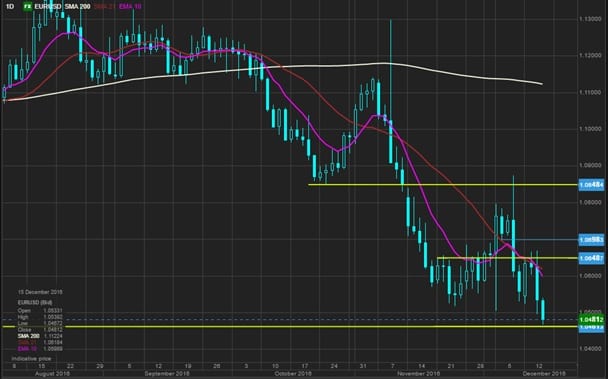Yesterday’s 25 basis point rate hike by the US Fed was not exactly a surprise, yet the Fed’s move clearly wasn’t fully baked into the currency markets. Since the rate move the benchmark EURUSD has dropped by nearly 2% from the 1.065 range to below 1.05.
It now looks like we may be heading toward Euro-Dollar parity.
John Hardy, Head of FX Strategy at Saxo Bank explains. More of John’s research can be seen at Saxo Bank’s TradingFloor.com.
FX Update: Defensive Fed sparks fresh USD strength
- FOMC and Yellen largely in-line with our “clueless hike” scenario
- Signals 3 hikes in 2017 but also caution on Trump implications
- Fed isn’t in the driver’s seat – the economy, Donald Trump and Congress are

John Hardy, Saxo Bank
Yesterday’s Federal Open Market Committee meeting statement and Janet Yellen press conference were largely in-line with our “clueless hike” scenario, as the Fed largely avoided making any notable adjustments in its economic forecasts (a minor 2017 adjustment higher in GDP by 0.1% and a slight lowering of the anticipated unemployment rate merely due to its recent drop, and slight raising of the headline inflation, but did not raise the upper range of core inflation forecasts).
These tweaks were mostly an admission of inflation and unemployment figures baked into the cake from the oil price rise and recent data, respectively, while the GDP adjustment was too minor to deserve comment. The shift higher in the forecasted policy rate for 2017 to suggest the likelihood of three hikes next year, however, is perhaps the clearest admission that the Fed feels the need to play a bit of defence up front on the risk that a Trump programme of tax cuts and fiscal stimulus will bring higher inflation and could pressure wage inflation as the economy heats up from the stimulus.
In her press conference opening statement, Fed chair Yellen also proclaimed that changes in fiscal policy could alter the economic outlook, essentially admitting that it will have to play catchup with the government’s policy mix, if it provides sufficient oomph to move the employment and inflation needles. In the Q&A session, meanwhile, Yellen also explicitly stepped away from previous language suggesting that the Fed is willing to let the economy run a bit hot before responding with policy tightening. Finally, there was a generic admission, when asked about the possible fiscal policy outlook, that “we’re under a cloud of uncertainty.”
The important thing here may be that we shouldn’t draw a strong conclusion about what the Fed said here or and the drama of an additional rate hike possibility in 2017, but that the market still sees the prospects of a Trump policy mix as possibly driving inflation and higher interest rates, and a Fed that will have to – and has declared itself likely to – respond to that.
The Fed is not in the driver’s seat – the economy and Donald Trump and Congress are. The strong USD reaction to yesterday’s meeting looks justified, especially given the rise in US interest rates all along the curve (the 2-year shot up more than 10 basis points to 1.50% and the 10-year rate was well above the key 2.50% area) and may continue from here into year-end, especially if the Bank of Japan fails to throw up any roadblocks at its bond auction tonight/tomorrow (20-year debt on the block – interesting as it is beyond the declared yield curve control portion of BoJ policy, though they recently shifted to buying more longer bonds) or at its policy early next week.
Today, we’re on to four more central bank meetings, though we’re expecting little to nothing from the Bank of England and the Swiss National Bank, while the Norges Bank has some room to surprise as NOK has been recently bulled up to important resistance and a suddenly fading oil price leaves the currency vulnerable to a dovish/unchanged message from the meeting today.
Yesterday, some macroprudential measures aimed at stemming real estate price rises in Oslo were announced that suggest a determination to nip further house price rises in the bud. This may also lead to the suspicion that the central bank will hope that the finance ministry will do more of the heavy lifting to avoid financial stability risks without having to resort to interest rate increases any time soon.
Beware that a particularly low miss on US CPI today could generate significant USD volatility and spoil the USD parade temporarily – not an expectation, merely a risk.
Chart: EURUSD
USDJPY was, of course, ground zero for the fresh surge in the US dollar in the wake of the FOMC meeting, but the technical situation in EURUSD is more interesting, given the clear importance of the 1.0500 level and the nominal lows just below from early 2015 around 1.0460. The parity talk will switch into high gear is we close this week below 1.0500, and really, that level isn’t that far away.
Source. SaxoTraderGO
Upcoming Economic Calendar Highlights (all times GMT)
- 0830 – Sweden Nov. Unemployment Rate
- 0830 – Switzerland Swiss National Bank decision on Libor Target Rate
- 0900 – Norway Norges Bank announces Deposit Rate
- 0900 – Eurozone Dec. Markit Preliminary Manufacturing PMI
- 0930 – UK Nov. Retail Sales
- 1200 – UK Bank of England Rate and Asset Purchase Target Decisions
- 1330 – Canada Oct. Manufacturing Sales
- 1330 – US Dec. Empire Manufacturing
- 1330 – US Nov. CPI
- 1330 – US Weekly Initial Jobless Claims
- 1330 – US Dec. Philadelphia Fed Survey
- 1500 – US Dec. NAHB Housing Market Index
- 1615 – Canada Bank of Canada’s Poloz to give Press Conference

